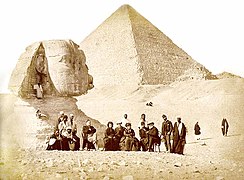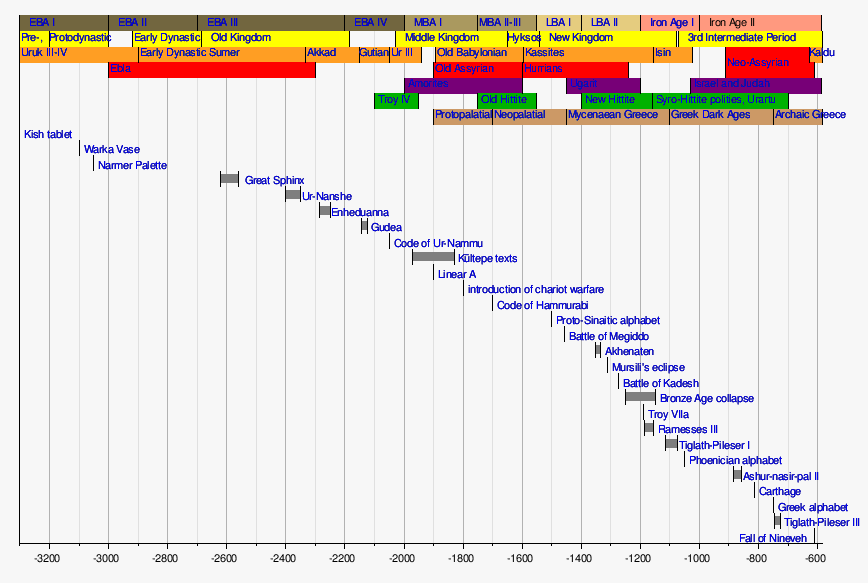art.wikisort.org - Sculpture
The Great Sphinx of Giza is a limestone statue of a reclining sphinx, a mythical creature with the head of a human, and the body of a lion.[1] Facing directly from west to east, it stands on the Giza Plateau on the west bank of the Nile in Giza, Egypt. The face of the Sphinx appears to represent the pharaoh Khafre.[2]
 | |
| Location | Giza, Egypt |
|---|---|
| Region | Egypt |
| Coordinates | 29°58′31″N 31°08′16″E |
| Length | 73 metres (240 ft) |
| Width | 19 metres (62 ft) |
| Height | 20 metres (66 ft) |
| History | |
| Material | Limestone |
| Site notes | |
| Condition | Partially restored |
The original shape of the Sphinx was cut from the bedrock, and has since been restored with layers of limestone blocks.[3] It measures 73 m (240 ft) long from paw to tail, 20 m (66 ft) high from the base to the top of the head and 19 m (62 ft) wide at its rear haunches.[4] Its nose was broken off for unknown reasons between the 3rd and 10th centuries AD.
The Sphinx is the oldest known monumental sculpture in Egypt and one of the most recognisable statues in the world. The archaeological evidence suggests that it was created by ancient Egyptians of the Old Kingdom during the reign of Khafre (c. 2558–2532 BC).[5][6][7]
Names
The original name the Old Kingdom creators gave the Sphinx is unknown, as the Sphinx temple, enclosure and possibly the Sphinx itself was not completed at the time, thus cultural material was limited.[8] In the New Kingdom, the Sphinx was revered as the solar deity Hor-em-akhet (English: "Horus of the Horizon"; Hellenized: Harmachis),[9] and the pharaoh Thutmose IV (1401–1391 or 1397–1388 BC)[lower-alpha 1] specifically referred to it as such in his Dream Stele.[10]
The commonly used name "Sphinx" was given to it in classical antiquity, about 2,000 years after the commonly accepted date of its construction by reference to a Greek mythological beast with the head of a woman, a falcon, a cat, or a sheep and the body of a lion with the wings of an eagle. (although, like most Egyptian sphinxes, the Great Sphinx has a man's head and no wings).[11] The English word sphinx comes from the ancient Greek Σφίγξ (transliterated: sphinx) apparently from the verb σφίγγω (transliterated: sphingo / English: to squeeze), after the Greek sphinx who strangled anyone who failed to answer her riddle.[citation needed]
Medieval Arab writers, including al-Maqrīzī, call the Sphinx by an Arabized Coptic name Belhib (Arabic: بلهيب) and Belhawiyya (Arabic: بلهويه),[12] which in turn comes from Ancient Egyptian: pꜣ-Ḥwr, a name of the Canaanite god Hauron with whom the Sphinx was identified. The modern Egyptian Arabic name is أبو الهول (ʼabu alhōl / ʼabu alhawl IPA: [ʔabulhoːl], "The Terrifying One"; literally "Father of Dread") which is a phono-semantic matching of the Coptic name.[13]
History
Old Kingdom

The archaeological evidence suggests that the Great Sphinx was created around 2500 BC for the pharaoh Khafre, the builder of the Second Pyramid at Giza.[14] The Sphinx is a monolith carved from the bedrock of the plateau, which also served as the quarry for the pyramids and other monuments in the area.[15] Egyptian geologist Farouk El-Baz has suggested that the head of the Sphinx may have been carved first, out of a natural yardang, i.e. a ridge of bedrock that had been sculpted by the wind. These can sometimes achieve shapes which resemble animals. El-Baz suggests that the "moat" or "ditch" around the Sphinx may have been quarried out later to allow for the creation of the full body of the sculpture.[16]
The stones cut from around the Sphinx' body were used to construct a temple in front of it, however neither the enclosure nor the temple were ever completed, and the relative scarcity of Old Kingdom cultural material suggests that a Sphinx cult was not established at the time.[17] Selim Hassan, writing in 1949 on recent excavations of the Sphinx enclosure, made note of this circumstance:
Taking all things into consideration, it seems that we must give the credit of erecting this, the world's most wonderful statue, to Khafre, but always with this reservation: that there is not one single contemporary inscription which connects the Sphinx with Khafre, so sound as it may appear, we must treat the evidence as circumstantial, until such time as a lucky turn of the spade of the excavator will reveal to the world a definite reference to the erection of the Sphinx.[18]
In order to construct the temple, the northern perimeter-wall of the Khafre Valley Temple had to be deconstructed, hence it follows that the Khafre funerary complex preceded the creation of the Sphinx and its temple. Furthermore, the angle and location of the south wall of the enclosure suggests the causeway connecting Khafre's Pyramid and Valley Temple already existed before the Sphinx was planned. The lower base level of the Sphinx temple also indicates that it doesn't pre-date the Valley Temple.[5]
New Kingdom
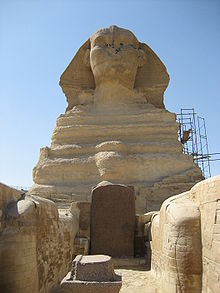
Some time around the First Intermediate Period, the Giza Necropolis was abandoned, and drifting sand eventually buried the Sphinx up to its shoulders. The first documented attempt at an excavation dates to c. 1400 BC, when the young Thutmose IV (1401–1391 or 1397–1388 BC) gathered a team and, after much effort, managed to dig out the front paws, between which he erected a shrine that housed the Dream Stele, an inscribed granite slab (possibly a repurposed door lintel from one of Khafre's temples). When the stele was discovered, its lines of text were already damaged and incomplete. An excerpt reads:
... the royal son, Thothmos, being arrived, while walking at midday and seating himself under the shadow of this mighty god, was overcome by slumber and slept at the very moment when Ra is at the summit [of heaven]. He found that the Majesty of this august god spoke to him with his own mouth, as a father speaks to his son, saying: Look upon me, contemplate me, O my son Thothmos; I am thy father, Harmakhis-Khopri-Ra-Tum; I bestow upon thee the sovereignty over my domain, the supremacy over the living ... Behold my actual condition that thou mayest protect all my perfect limbs. The sand of the desert whereon I am laid has covered me. Save me, causing all that is in my heart to be executed.[19]
The Dream Stele associates the Sphinx with Khafre, however this part of the text is not entirely intact:
which we bring for him: oxen ... and all the young vegetables; and we shall give praise to Wenofer ... Khaf ... the statue made for Atum-Hor-em-Akhet.[20]
Egyptologist Thomas Young, finding the Khaf hieroglyphs in a damaged cartouche used to surround a royal name, inserted the glyph ra to complete Khafre's name. When the Stele was re-excavated in 1925, the lines of text referring to Khaf flaked off and were destroyed.[citation needed]
Later, Ramesses II the Great (1279–1213 BC) may have undertaken a second excavation.
In the New Kingdom, the Sphinx became more specifically associated with the sun god Hor-em-akhet (Hellenized: Harmachis) or "Horus-at-the-Horizon". Pharaoh Amenhotep II (1427–1401 or 1397 BC) built a temple to the northeast of the Sphinx nearly 1000 years after its construction and dedicated it to the cult of Hor-em-akhet.[21]
Graeco-Roman period
In Graeco-Roman times, Giza had become a tourist destination—the monuments were regarded as antiquities—and some Roman Emperors visited the Sphinx out of curiosity, and for political reasons.[22]
The Sphinx was cleared of sand again in the first century AD in honor of Emperor Nero and the Governor of Egypt Tiberius Claudius Balbilus.[23] A monumental stairway—more than 12 metres (39 ft) wide—was erected, leading to a pavement in front of the paws of the Sphinx. At the top of the stairs, a podium was positioned that allowed view into the Sphinx sanctuary. Further back, another podium neighbored several more steps.[24] The stairway was dismantled during the 1931–32 excavations by Émile Baraize.[25]
Pliny the Elder describes the face of the Sphinx being colored red and gives measurements for the statue:[26]
In front of these pyramids is the Sphinx, a still more wondrous object of art, but one upon which silence has been observed, as it is looked upon as a divinity by the people of the neighbourhood. It is their belief that King Harmaïs was buried in it, and they will have it that it was brought there from a distance. The truth is, however, that it was hewn from the solid rock; and, from a feeling of veneration, the face of the monster is coloured red. The circumference of the head, measured round the forehead, is one hundred and two feet, the length of the feet being one hundred and forty-three, and the height, from the belly to the summit of the asp on the head, sixty-two.
A stela dated to 166 AD commemorates the restoration of the retaining walls surrounding the Sphinx.[27] The last Emperor connected with the monument is Septimius Severus, around 200 AD.[28] With the downfall of Roman power, the Sphinx was once more engulfed by the sands.[29]
 Side view of the Sphinx with the Roman stairway on the right.
Side view of the Sphinx with the Roman stairway on the right. Top of the Roman stairway before dismantling in 1931-32.
Top of the Roman stairway before dismantling in 1931-32. Map of the area east of the Sphinx by Henry Salt.
Map of the area east of the Sphinx by Henry Salt.
Middle Ages
Some ancient non-Egyptians saw it as a likeness of the god Horon. The cult of the Sphinx continued into medieval times. The Sabians of Harran saw it as the burial place of Hermes Trismegistus. Arab authors described the Sphinx as a talisman which guarded the area from the desert.[30] Al-Maqrizi describes it as the "talisman of the Nile" of which the locals believed the flood cycle depended upon.[31] Muhammad al-Idrisi stated that those wishing to obtain bureaucratic positions in the Egyptian government gave incense offering to the monument.[32]
Early European descriptions of the Great Sphinx of Giza
Over the centuries, writers and scholars have recorded their impressions and reactions upon seeing the Sphinx. The vast majority were concerned with a general description, often including a mixture of science, romance and mystique.[citation needed] A typical[citation needed] description of the Sphinx by tourists and leisure travelers throughout the 19th and 20th century was made by John Lawson Stoddard:
It is the antiquity of the Sphinx which thrills us as we look upon it, for in itself it has no charms. The desert's waves have risen to its breast, as if to wrap the monster in a winding-sheet of gold. The face and head have been mutilated by Moslem fanatics. The mouth, the beauty of whose lips was once admired, is now expressionless. Yet grand in its loneliness, – veiled in the mystery of unnamed ages, – the relic of Egyptian antiquity stands solemn and silent in the presence of the awful desert – symbol of eternity. Here it disputes with Time the empire of the past; forever gazing on and on into a future which will still be distant when we, like all who have preceded us and looked upon its face, have lived our little lives and disappeared.[33]
From the 16th-19th centuries, European observers described the Sphinx having the face, neck and breast of a woman. Examples included Johannes Helferich (1579), George Sandys (1615), Johann Michael Vansleb (1677), Benoît de Maillet (1735) and Elliot Warburton (1844).
Most early Western images were book illustrations in print form, elaborated by a professional engraver from either previous images available or some original drawing or sketch supplied by an author, and usually now lost. Seven years after visiting Giza, André Thévet (Cosmographie de Levant, 1556) described the Sphinx as "the head of a colossus, caused to be made by Isis, daughter of Inachus, then so beloved of Jupiter". He, or his artist and engraver, pictured it as a curly-haired monster with a grassy dog collar. Athanasius Kircher (who never visited Egypt) depicted the Sphinx as a Roman statue (Turris Babel, 1679). Johannes Helferich's (1579) Sphinx is a pinched-face, round-breasted woman with a straight haired wig. George Sandys stated that the Sphinx was a harlot; Balthasar de Monconys interpreted the headdress as a kind of hairnet, while François de La Boullaye-Le Gouz's Sphinx had a rounded hairdo with bulky collar.[citation needed]
Richard Pococke's Sphinx was an adoption of Cornelis de Bruijn's drawing of 1698, featuring only minor changes, but is closer to the actual appearance of the Sphinx than anything previous. The print versions of Norden's drawings for his Voyage d'Egypte et de Nubie, 1755 clearly show that the nose was missing.
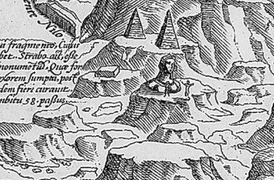
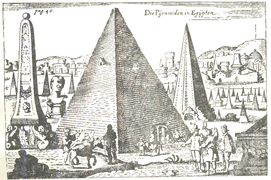 Jan Sommer, (unpublished) Voyages en Egypte des annees 1589, 1590 & 1591, Institut de France, 1971 (Voyageurs occidentaux en Égypte 3)
Jan Sommer, (unpublished) Voyages en Egypte des annees 1589, 1590 & 1591, Institut de France, 1971 (Voyageurs occidentaux en Égypte 3)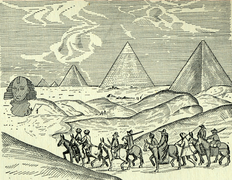 George Sandys, A relation of a journey begun an dom. 1610 (1615)
George Sandys, A relation of a journey begun an dom. 1610 (1615)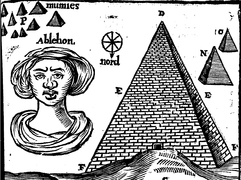 François de La Boullaye-Le Gouz, Les Voyages et Observations (1653)
François de La Boullaye-Le Gouz, Les Voyages et Observations (1653)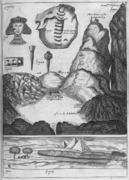 Balthasar de Monconys, Journal des voyages (1665)
Balthasar de Monconys, Journal des voyages (1665) Olfert Dapper, Description de l'Afrique (1665), note the two different displays of the Sphinx.
Olfert Dapper, Description de l'Afrique (1665), note the two different displays of the Sphinx.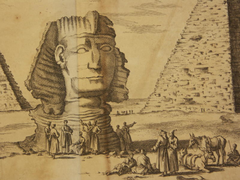 Cornelis de Bruijn, Reizen van Cornelis de Bruyn door de vermaardste Deelen van Klein Asia (1698)
Cornelis de Bruijn, Reizen van Cornelis de Bruyn door de vermaardste Deelen van Klein Asia (1698) Johanne Baptista Homann (map), Aegyptus hodierna (1724)
Johanne Baptista Homann (map), Aegyptus hodierna (1724) Frederic Louis Norden, Voyage d'Égypte et de Nubie (1755)
Frederic Louis Norden, Voyage d'Égypte et de Nubie (1755)
Modern excavations
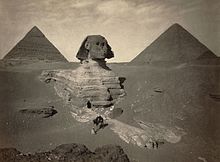

In 1817, the first modern archaeological dig, supervised by the Italian Giovanni Battista Caviglia, uncovered the Sphinx's chest completely.
In the beginning of the year 1887, the chest, the paws, the altar, and plateau were all made visible. Flights of steps were unearthed, and finally accurate measurements were taken of the great figures. The height from the lowest of the steps was found to be one hundred feet, and the space between the paws was found to be thirty-five feet long and ten feet wide. Here there was formerly an altar; and a stele of Thûtmosis IV was discovered, recording a dream in which he was ordered to clear away the sand that even then was gathering round the site of the Sphinx.[34]
One of the people working on clearing the sands from around the Great Sphinx was Eugène Grébaut, a French Director of the Antiquities Service.[35]
Opinions of early Egyptologists
Early Egyptologists and excavators were of divided opinion regarding the age of the Sphinx and the associated temples.
In 1857, Auguste Mariette, founder of the Egyptian Museum in Cairo, unearthed the much later Inventory Stela (estimated to be from the Twenty-sixth Dynasty, c. 664–525 BC), which tells how Khufu came upon the Sphinx, already buried in sand. Although certain tracts on the Stela are likely accurate,[36] this passage is contradicted by archaeological evidence, thus considered to be Late Period historical revisionism,[37] a purposeful fake, created by the local priests as an attempt to imbue the contemporary Isis temple with an ancient history it never had. Such acts became common when religious institutions such as temples, shrines and priests' domains were fighting for political attention and for financial and economic donations.[38][39]
Flinders Petrie wrote in 1883 regarding the state of opinion of the age of the Khafre Valley Temple, and by extension the Sphinx: "The date of the Granite Temple has been so positively asserted to be earlier than the fourth dynasty, that it may seem rash to dispute the point. Recent discoveries, however, strongly show that it was really not built before the reign of Khafre, in the fourth dynasty."[40]
Gaston Maspero, the French Egyptologist and second director of the Egyptian Museum in Cairo, conducted a survey of the Sphinx in 1886. He concluded that because the Dream Stela showed the cartouche of Khafre in line 13, it was he who was responsible for the excavation and therefore the Sphinx must predate Khafre and his predecessors—possibly Fourth Dynasty, c. 2575–2467 BC. Maspero believed the Sphinx to be "the most ancient monument in Egypt".[41]
Ludwig Borchardt attributed the Sphinx to the Middle Kingdom, arguing that the particular features seen on the Sphinx are unique to the 12th dynasty and that the Sphinx resembles Amenemhat III.[42]
E. A. Wallis Budge agreed that the Sphinx predated Khafre's reign, writing in The Gods of the Egyptians (1904): "This marvelous object [the Great Sphinx] was in existence in the days of Khafre, or Khephren,[lower-alpha 2] and it is probable that it is a very great deal older than his reign and that it dates from the end of the archaic period [c. 2686 BC]."[43]
Selim Hassan reasoned that the Sphinx was erected after the completion of the Khafre pyramid complex.[44]
Modern dissenting hypotheses
Rainer Stadelmann, former director of the German Archaeological Institute in Cairo, examined the distinct iconography of the nemes (headdress) and the now-detached beard of the Sphinx and concluded the style is more indicative of the pharaoh Khufu (2589–2566 BC), known to the Greeks as Cheops, builder of the Great Pyramid of Giza and Khafre's father.[45] He supports this by suggesting Khafre's Causeway was built to conform to a pre-existing structure, which, he concludes, given its location, could only have been the Sphinx.[46]
In 2004, Vassil Dobrev of the Institut Français d'Archéologie Orientale in Cairo announced he had uncovered new evidence that the Great Sphinx may have been the work of the little-known pharaoh Djedefre (2528–2520 BC), Khafra's half brother and a son of Khufu.[47] Dobrev suggests Djedefre built the Sphinx in the image of his father Khufu, identifying him with the sun god Ra in order to restore respect for their dynasty. Dobrev also says that the causeway connecting Khafre's pyramid to the temples was built around the Sphinx, suggesting it was already in existence at the time. Egyptologist Nigel Strudwick responded to Dobrev saying that "It is not implausible. But I would need more explanation, such as why he thinks the pyramid at Abu Roash is a sun temple, something I'm sceptical about. I have never heard anyone suggest that the name in the graffiti at Zawiyet el-Aryan mentions Djedefre. I remain more convinced by the traditional argument of it being Khafre or the more recent theory of it being Khufu."[48]
Recent restorations
In 1931, engineers of the Egyptian government repaired the head of the Sphinx. Part of its headdress had fallen off in 1926 due to erosion, which had also cut deeply into its neck.[49] This questionable repair was by the addition of a concrete collar between the headdress and the neck, creating an altered profile.[50] Many renovations to the stone base and raw rock body were done in the 1980s, and then redone in the 1990s.[51]
Degradation and violation
The nummulitic limestone of the area consists of layers which offer differing resistance to erosion (mostly caused by wind and windblown sand), leading to the uneven degradation apparent in the Sphinx's body.[15][52] The lowest part of the body, including the legs, is solid rock.[1] The body of the animal up to its neck is fashioned from softer layers that have suffered considerable disintegration.[53] The layer in which the head was sculpted is much harder.[53][54] A number of "dead-end" shafts are known to exist within and below the body of the Great Sphinx, most likely dug by treasure hunters and tomb robbers.
Missing nose

Examination of the Sphinx's face shows that long rods or chisels were hammered into the nose area, one down from the bridge and another beneath the nostril, then used to pry the nose off towards the south, resulting in the one-metre wide nose still being lost to date.[55] Mark Lehner, who performed an archaeological study, concluded that it was intentionally broken with instruments at an unknown time between the 3rd and 10th centuries AD.[56]

Drawings of the Sphinx by Frederic Louis Norden in 1737 show the nose missing.[57] Many folk tales exist regarding the destruction of its nose, aiming to provide an answer as to where it went or what happened to it. One tale erroneously attributes it to cannonballs fired by the army of Napoleon Bonaparte. Other tales ascribe it to being the work of Mamluks. Since the 10th century, some Arab authors have claimed it to be a result of iconoclastic attacks.[56]
The Arab historian al-Maqrīzī, writing in the 15th century, attributes the loss of the nose to Muhammad Sa'im al-Dahr, a Sufi Muslim from the khanqah of Sa'id al-Su'ada in 1378, who found the local peasants making offerings to the Sphinx in the hope of increasing their harvest and therefore defaced the Sphinx in an act of iconoclasm. According to al-Maqrīzī, many people living in the area believed that the increased sand covering the Giza Plateau was retribution for al-Dahr's act of defacement.[58][59] Ibn Qadi Shuhba mentions his name as Muhammad ibn Sadiq ibn al-Muhammad al-Tibrizi al-Masri, who died in 1384. He attributed the desecration of the sphinxes of Qanatir al-Siba built by the sultan Baybars to him, and also said he might have desecrated the Great Sphinx. Al-Minufi stated that the Alexandrian Crusade in 1365 was divine punishment for a Sufi sheikh of the khanqah of Sa'id breaking off the nose.[32]
Beard
![Limestone fragments of the Sphinx's beard in the British Museum, 14th century BC.[60]](http://upload.wikimedia.org/wikipedia/commons/thumb/0/01/Beard_of_the_sphinx.jpg/170px-Beard_of_the_sphinx.jpg)
In addition to the lost nose, a ceremonial pharaonic beard is thought to have been attached, although this may have been added in later periods after the original construction. Egyptologist Vassil Dobrev has suggested that had the beard been an original part of the Sphinx, it would have damaged the chin of the statue upon falling.[48] The lack of visible damage supports his theory that the beard was a later addition.[citation needed]
Residues of red pigment are visible on areas of the Sphinx's face and traces of yellow and blue pigment have also been found elsewhere on the Sphinx, leading Mark Lehner to suggest that the monument "was once decked out in gaudy comic book colours".[61] However, as with the case of many ancient monuments, the pigments and colours have since deteriorated, resulting in the yellow/beige appearance it has today.
Holes and tunnels

Hole in the Sphinx's head
Johann Helffrich visited the Sphinx during his travels in 1565–1566. He describes that a priest went into the head of the Sphinx, and when he spoke it was as if the Sphinx itself was speaking.[62]
Many New Kingdom stelae depict the Sphinx wearing a crown. If it in fact existed, the hole could have been the anchoring point for it.[63][64]
Émile Baraize closed the hole with a metal hatch in 1926.[65][66]
Perring's Hole

Howard Vyse directed Perring in 1837 to drill a tunnel in the back of the Sphinx, just behind the head. The boring rods became stuck at a depth of 27 feet (8.2 m), Attempts to blast the rods free caused further damage. The hole was cleared in 1978. Among the rubble was a fragment of the Sphinx's nemes headdress.[67]
Major fissure
A major natural fissure in the bedrock cuts through the waist of the Sphinx, first excavated by Auguste Mariette in 1853.
At the top of the back it measures up to 2 metres (6.6 ft) in width. Baraize, in 1926, sealed the sides and roofed it with iron bars, limestone and cement, and installed an iron trap door at the top. The sides of the fissure might have been artificially squared; however, the bottom is irregular bedrock, about 1 metre (3.3 ft) above the outside floor. A very narrow crack continues deeper.[68]
Rump passage
In 1926 the Sphinx was cleared of sand under direction of Baraize, which revealed an opening to a tunnel at floor-level at the north side of the rump. It was subsequently closed by masonry veneer and nearly forgotten.
More than fifty years later, the existence of the passage was recalled by three elderly men who had worked during the clearing as basket carriers. This led to the rediscovery and excavation of the rump passage, in 1980.
The passage consists of an upper and a lower section, which are angled roughly 90 degrees to each other:
- The upper part ascends to a height of 4 metres (13 ft) above the ground-floor at a northwest direction. It runs between masonry veneer and the core body of the Sphinx and ends in a niche 1 metre (3.3 ft) wide and 1.8 metres (5.9 ft) high. The ceiling of the niche consists of modern cement, which likely spilled down from the filling of the gap between masonry and core bedrock, some 3 metres (9.8 ft) above.
- The lower part descends steeply into the bedrock toward northeast, for a distance of approximately 4 metres (13 ft) and a depth of 5 metres (16 ft). It terminated in a cul-de-sac pit at groundwater level. At the entrance it is 1.3 metres (4.3 ft) wide, narrowing to about 1.07 metres (3.5 ft) towards the end. Among the sand and stone fragments, a piece of tin foil and the base of a modern ceramic water jar was found. The clogged bottom contained modern fill. Among it, more tin foil, modern cement and a pair of shoes.
It is possible that the entire passage was cut top down, beginning high up on the rump, and that the current access point at floor-level was made at a later date.
Vyse noted in his diary (February 27 and 28, 1837) that he was "boring" near the tail, which indicates him as the creator of the passage, as no other tunnel has been identified at this location.[69] Another interpretation is that the shaft is of ancient origin, perhaps an exploratory tunnel or an unfinished tomb shaft.[70]
 Rump of the Sphinx, with passage entrance at floor-level.
Rump of the Sphinx, with passage entrance at floor-level. Closeup of the entrance hole of the rump shaft.
Closeup of the entrance hole of the rump shaft. Inside the passage, looking up, seeing entrance stones and upper tunnel.
Inside the passage, looking up, seeing entrance stones and upper tunnel.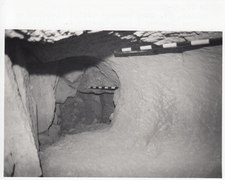 Looking up the upper tunnel.
Looking up the upper tunnel. Ceiling of upper tunnel.
Ceiling of upper tunnel. Looking down the upper part from chamber 1.
Looking down the upper part from chamber 1. Lower part of rump passage, before excavation.
Lower part of rump passage, before excavation. Lower part after excavation.
Lower part after excavation.
Niche in northern flank
A 1925 photograph shows a man standing below floor level in a niche in the Sphinx's core body. It was closed during the 1925-6 restorations.[71]
Gap under southern large masonry box
Another hole might have been at floor level in the large masonry box on the south side of the Sphinx.[71]
Space behind Dream Stele
The space behind the Dream Stele, between the paws of the Sphinx, was covered by an iron beam and cement roof, which was fitted with an iron trap door.[72][73]
Keyhole Shaft
At the ledge of the Sphinx enclosure, a square shaft is located opposite the northern hind paw. It was cleared during excavation in 1978 by Hawass and measures 1.42 by 1.06 metres (4.7 by 3.5 ft) and about 2 metres (6.6 ft) deep. Lehner interprets the shaft to be an unfinished tomb and named it "Keyhole Shaft", because a cuttings in the ledge above the shaft is shaped like the lower part of a keyhole, upside down.[74]
Pseudohistory
Numerous ideas have been suggested to explain or reinterpret the origin and identity of the Sphinx, that lack sufficient evidential support and/or are contradicted by such, and are therefore considered part of pseudohistory and pseudoarchaeology.
Ancient Astronauts/Atlantis
- The Sphinx is oriented from west to east, towards the rising sun, in accordance with the ancient Egyptian solar cult. The Orion correlation theory posits that it was instead aligned to face the constellation of Leo during the vernal equinox around 10,500 BC. The idea is considered pseudoarchaeology by academia, because no textual or archaeological evidence supports this to be the reason for the orientation of the Sphinx.[75][76][77][78]

Weathering on the Sphinx's body (north-eastern exposure) - The Sphinx water erosion hypothesis contends that the main type of weathering evident on the enclosure walls of the Great Sphinx could only have been caused by prolonged and extensive rainfall,[79] and must therefore predate the time of the pharaoh Khafre. The hypothesis was championed by René Schwaller de Lubicz, John Anthony West, and geologist Robert M. Schoch. The theory is considered pseudoarchaeology by mainstream scholarship due to archaeological, climatological and geological evidence to the contrary.[80][81][82]
- There is a long history of speculation about hidden chambers beneath the Sphinx, by esoteric figures such as H. Spencer Lewis. Edgar Cayce specifically predicted in the 1930s that a "Hall of Records", containing knowledge from Atlantis, would be discovered under the Sphinx in 1998. His prediction fueled much of the fringe speculation that surrounded the Sphinx in the 1990s, which lost momentum when the hall was not found when predicted.[83]
- Author Robert K. G. Temple proposes that the Sphinx was originally a statue of the jackal god Anubis, the god of funerals, and that its face was recarved in the likeness of a Middle Kingdom pharaoh, Amenemhet II. Temple bases his identification on the style of the eye make-up and style of the pleats on the headdress.[84]
Racial characteristics
Until the early 20th century, it was suggested that the face of the Sphinx had "Negroid" characteristics, as part of now outdated historical race concepts.[85][86]
Other Alternative Ages
Geologist Colin Reader suggests that water runoff from the Giza plateau is responsible for the differential erosion on the walls of the sphinx enclosure. Because the hydrological characteristics of the area were significantly changed by the quarries, he contends this suggests that the sphinx likely predated the quarries (and thus, the pyramids). He points towards the larger cyclopean stones in part of the Sphinx Temple, as well as the causeway alignment with the pyramids and the break in the quarries, as evidence that the pyramids took the alignment with some pre-existing structure, such as the sphinx, into consideration when they were constructed, and that the sphinx temple was built in two distinct phases. He contends that such erosion could have occurred relatively rapidly and suggests that the sphinx was no more than a few centuries older than present archaeology would suggest, suggesting an origin from the late pre-Dynastic or early Dynastic era, when Ancient Egyptians already were known to be capable of sophisticated masonry.[37]
Gallery
 Description de l'Egypte, Planches, Antiquités, volume V (1823)
Description de l'Egypte, Planches, Antiquités, volume V (1823) Description de l'Egypte, Planches, Antiquités, volume V (1823)
Description de l'Egypte, Planches, Antiquités, volume V (1823) Members of the Second Japanese Embassy to Europe (1863) in front of the Sphinx, 1864
Members of the Second Japanese Embassy to Europe (1863) in front of the Sphinx, 1864- French archaeologist Auguste Mariette (seated, far left) and Emperor Pedro II of Brazil (seated, far right) with others in front of the Sphinx, 1871
- The Great Sphinx partly under the sand, ca. 1870s
- Rear view of the Sphinx in 2014, showing some of the restoration work up to that time.
See also
- Sphinx of Memphis
- Sphinx of Taharqo
- African lions in culture
- Lion (heraldry)
- List of colossal sculpture in situ
- List of tallest statues
Notes
- See Thutmose IV#Dates and length of reign
- Early Egyptologists were inconsistent in their transliteration of pharaonic names: Khafre and Khephren are both references to Khafre.
References
- "The Great Sphinx of Giza". Ancient History Encyclopedia. Archived from the original on 12 June 2018. Retrieved 7 December 2016.
- Sims, Lesley (2000). "The Great Pyramids". A Visitor's Guide to Ancient Egypt. Saffron Hill, London: Usborne Publishing. p. 17. ISBN 0-7460-30673.
- "Saving the Sphinx – NOVA | PBS". pbs.org. Retrieved 7 December 2016.
- Rigano, Charles (2014). Pyramids of the Giza Plateau. p. 148. ISBN 9781496952493.
- "Sphinx Project « Ancient Egypt Research Associates". 10 September 2009. Retrieved 12 November 2021.
- Dunford, Jane; Fletcher, Joann; French, Carole (ed., 2007). Egypt: Eyewitness Travel Guide Archived 2009-02-18 at the Wayback Machine. London: Dorling Kindersley, 2007. ISBN 978-0-7566-2875-8.
- Lehner 1991.
- Lehner 1991, p. 96.
- Hawkes, Jacquetta (1974). Atlas of Ancient Archaeology. McGraw-Hill Book Company. p. 150. ISBN 0-07-027293-X.
- Bryan, Betsy M. (1991) The Reign of Thutmose IV. The Johns Hopkins University Press. pp. 145–146
- "sphinx | mythology". Encyclopædia Britannica. Retrieved 7 December 2016.
- "ص229 - كتاب المواعظ والاعتبار بذكر الخطط والآثار - ذكر الصنم الذي يقال له أبو الهول - المكتبة الشاملة الحديثة". al-maktaba.org. Retrieved 12 November 2021.
- Peust, Carsten. "Die Toponyme vorarabischen Ursprungs im modernen Ägypten" (PDF). p. 46.
- "Sphinx Project: Why Sequence is Important". 2007. Archived from the original on 26 July 2010. Retrieved 27 February 2015.
- Zuberbühler, Franz Löhner, Teresa. "Stone quarries in ancient Egypt. Details about the Giza quarries, the granite quarries in Assuan and the Tura limestone quarries". cheops-pyramide.ch. Retrieved 8 December 2016.
- Egyptology at the Dawn of the Twenty-first Century: Archaeology; INTERNATIONAL CONGRESS OF EGYPTOLOGISTS, Lyla Pinch Brock; American University in Cairo Press, 2003; pages 70-71
- "Who Built the Sphinx?" (PDF). Aeragram. 18–1: 2–6. 2017.
- Hassan 1953, p. 164.
- Mallet, Dominique, The Stele of Thothmes IV: A Translation, at harmakhis.org. Retrieved 3 January 2009.
- Colavito, Jason (2001). "Who Built the Sphinx?" at Lost Civilizations Discovered. Retrieved 19 December 2008.
- Stadelmann, Rainer (2001). "Giza". In Redford, Donald B. (ed), The Oxford Encyclopedia of Ancient Egypt. Volume II, p. 29
- Hassan 1953, p. 119.
- Lehner 1991, p. 34.
- Lehner 1991, p. 35.
- Lehner 1991, p. 62.
- Pliny the Elder. The Natural History.
- Hassan 1953, p. 123.
- Hassan 1953, p. 125.
- Hassan 1953, p. 124.
- Okasha El Daly (12 November 2005). Egyptology: The Missing Millennium : Ancient Egypt in Medieval Arabic Writings. Psychology Press. ISBN 9781844720637. Retrieved 12 November 2021 – via Google Books.
- Joseph E Lowry; Shawkat M Toorawa; Everett K Rowson (2017). Arabic Humanities, Islamic Thought: Essays in Honor of Everett K. Rowson. Boston Brill. p. 263. ISBN 9789004343245. OCLC 992515269. Retrieved 11 October 2017.
- Okasha El Daly (12 November 2005). Egyptology: The Missing Millennium : Ancient Egypt in Medieval Arabic Writings. Psychology Press. ISBN 9781844720637. Retrieved 12 November 2021 – via Google Books.
- Stoddard, John L. (1 March 2009). John L. Stoddard's Lectures. Wildside Press LLC. p. 333. ISBN 978-1-4344-5271-9.
- Rappoport, S. (17 December 2005). The Project Gutenberg EBook of History Of Egypt From 330 B.C. To The Present Time, Volume 12 (of 12), by S. Rappoport. The Grolier Society Publishers, London. Archived from the original on 4 March 2016. Retrieved 31 October 2016.
- "A Brief History of the Supreme Council of Antiquities (SCA): 1858 to present". SCA - Egypt. Archived from the original on 17 October 2016. Retrieved 21 March 2017.
- Hawass, Zahi. (The Khufu at The Plateau. Retrieved 6 January 2009.
- Colin, Reader (2002). "Giza Before the Fourth Dynasty". Journal of the Ancient Chronology Forum. Vol. 9. pp. 5–21. Archived from the original on 10 December 2013. Retrieved 11 October 2017.
- Verner, Miroslav (2007). The Pyramids: The Mystery, Culture, and Science of Egypt's Great Monuments. Grove/Atlantic Inc. p. 212. ISBN 978-0802198631.
- Jánosi, Peter (1996). Die Pyramidenanlagen der Königinnen (= Denkschriften der Gesamtakademie, Österreichische Akademie der Wissenschaften, volume 13. pp. 11, 125. ISBN 978-3700122074.
- Petrie, Flinders (1883). The Pyramids and Temples of Gizeh. London. p. 133.
- Hassan 1953, p. 17-18.
- Hassan 1953, p. 86-87.
- Wallis Budge, E. A. (1904). The Gods of the Egyptians: Studies in Egyptian Mythology. Courier Dover Publications. p. 361. ISBN 978-0-486-22055-0.
- Hassan 1953, p. 88.
- "NOVA | Transcripts | Riddles of the Sphinx | PBS". PBS.
- Reader, Colin. "Giza Before the Fourth Dynasty".
- Riddle of the Sphinx Retrieved 6 November 2010.
- Fleming, Nic (14 December 2004). "I have solved riddle of the Sphinx, says Frenchman". The Daily Telegraph. Archived from the original on 11 January 2022. Retrieved 28 June 2005.
- Popular Science Monthly, July 1931, page 56.
- "Filmed in 1897, THIS is the OLDEST footage of the Great Sphinx of Giza - Ancient Code". ancient-code.com. 17 April 2017. Retrieved 23 October 2017.
- Hawass, Zahi. "HISTORY OF THE CONSERVATION OF THE SPHINX". Retrieved 23 October 2017.
- "How old is the Sphinx?". msnbc.com. 11 February 1999. Retrieved 7 December 2016.
- "The Great Sphinx | Geology of a Statue | Dating the Sphinx | Ancient Egypt Research Associates". aeraweb.org. 13 October 2009. Retrieved 8 December 2016.
- Zivie-Coche, Christiane (2002). Sphinx: History of a Monument. Cornell University Press. pp. 99–100. ISBN 978-0-8014-3962-9.
- Lehner, Mark (1997). The Complete Pyramids. Thames & Hudson. p. 41. ISBN 978-0-500-05084-2.
- Christiane Zivie-Coche “Sphinx: History of a Monument” p. 16
- "F.L. Norden. Travels in Egypt and Nubia, 1757. Plate 47, Profil de la tête colossale du Sphinx". Brooklyn Museum. Archived from the original on 6 April 2016. Retrieved 24 January 2014.
- Joseph E Lowry; Shawkat M Toorawa; Everett K Rowson (2017). Arabic Humanities, Islamic Thought: Essays in Honor of Everett K. Rowson. Boston Brill. p. 264. ISBN 9789004343245. OCLC 992515269. Retrieved 11 October 2017.
- The Wonders of the Ancients: Arab-Islamic Representations of Ancient Egypt, Mark Fraser Pettigrew, page 201, University of California, Berkeley
- "British Museum - Fragment of the beard of the Great Sphinx". britishmuseum.org. Archived from the original on 18 October 2015.
- Evan Hadingham (February 2010). "Uncovering Secrets of the Sphinx". Smithsonian Magazine.
- Helffrich, Johann (1579). Kurtzer und warhafftiger Bericht, Von der Reis aus Venedig nach Hierusalem, Von dannen in Aegypten, auff den Berg Sinai, und folgends widerumb gen Venedig (in German). p. 195.
- Lehner 1991, p. 363.
- "Accessions of the Griffith Institute Archive in 2009".
- "360° photograph of the Sphinx".
- Lehner 1991, p. 187.
- Lehner 1991, pp. 204–205.
- Lehner 1991, pp. 202–203.
- Vyse, Howard (1840). Operations carried on at the pyramids of Gizeh in 1837. Vol. 1. pp. 173, 175.
- Lehner 1994.
- Lehner 1994, p. 215.
- Lehner 1991, p. 298.
- "360° photograph of the Sphinx".
- Lehner 1991, pp. 160–163.
- Hancock, Graham; Bauval, Robert (2000-12-14). Atlantis Reborn Again. Horizon. BBC. Aired 2000-12-14.
- Orser, Charles E. (2003). Race and practice in archaeological interpretation. University of Pennsylvania Press. p. 73. ISBN 978-0-8122-3750-4.
- Hancock, Graham; Bauval, Robert (1997). The Message of the Sphinx: A Quest for the Hidden Legacy of Mankind. Three Rivers Press. p. 271. ISBN 978-0-517-88852-0.
- Fagan, Garrett G., ed. (2006). Archaeological fantasies: how pseudoarchaeology misrepresents the past and misleads the public. Routledge. pp. 20, 38–40, 100–103, 127, 197–201, 238, 241–255. ISBN 978-0-415-30593-8.
- Schoch, Robert M. (1992). Redating the Great Sphinx of Giza. Archived from the original on 4 February 2016. Retrieved 11 October 2017.
- "Scholars Dispute Claim That Sphinx Is Much Older". The New York Times. Associated Press. 9 February 1992. Retrieved 12 November 2021.
- }White, Chris. The Age of the Sphinx? Reader versus Schoch. Archived from the original on 30 June 2016. Retrieved 1 July 2016.
- Reader, C. D. (February 2001). "A Geomorphological Study of the Giza Necropolis, with Implications for the Development of the Site". Archaeometry. 43 (1): 149–165. doi:10.1111/1475-4754.00009.
- MacDonald, Sally; Rice, Michael (2003). Consuming Ancient Egypt. UCL Press. pp. 180–181, 190. ISBN 978-1-84472-003-3.
- Robert K. G. Temple, The Sphinx Mystery: The Forgotten Origins of The Sanctuary of Anubis (Rochester, Vermont: Inner Traditions, 2009). ISBN 978-1-59477-271-9
- Regier, Willis G., ed. (2004). Book of the Sphinx. U of Nebraska Press. p. 157. ISBN 978-0-8032-3956-2.
- Irwin, Graham W. (1977). Africans abroad, Columbia University Press, p. 11
Bibliography
- Lehner, Mark (1991). Archaeology of an Image: The Great Sphinx of Giza.
- Lehner, Mark (1994). "The Passage Under the Sphinx". Hommages à Jean Leclant. 1: 201–216.
- Hassan, Selim (1953). Excavations at Giza 8: 1936-1937. The Great Sphinx and its Secrets. Historical Studies in the Light of the Recent Excavations. Cairo: Government Press.
External links
 Media related to Great Sphinx of Giza at Wikimedia Commons
Media related to Great Sphinx of Giza at Wikimedia Commons- Riddle of the Sphinx
- Egyptian and Greek Sphinxes
- Egypt—The Lost Civilization Theory
- The Sphinx's Nose
- What happened to the Sphinx's nose? Archived 16 May 2014 at the Wayback Machine
- Sphinx photo gallery
- Al Maqrizi's account (in Arabic)
- The Age of the Sphinx by Brian Dunning
На других языках
- [en] Great Sphinx of Giza
[es] Gran Esfinge de Guiza
La Gran Esfinge de Guiza[1][2] es una monumental escultura que se encuentra en la ribera occidental del río Nilo, en la ciudad de Guiza, unos veinte kilómetros al suroeste del centro de El Cairo, en Egipto. Los egiptólogos estiman que fue esculpida c. s. XXVI a. C., formando parte del complejo funerario del rey, durante la dinastía IV de Egipto.[it] Grande Sfinge di Giza
La Grande Sfinge di Giza è una scultura di pietra calcarea situata nella Necropoli di Giza, raffigurante una sfinge sdraiata, ovvero una figura mitologica con la testa di un uomo e il corpo di un leone (nello specifico è detta anche androsfinge o sfinge andricefala).[ru] Большой сфинкс
Большой сфинкс на западном берегу Нила в Гизе — древнейшая сохранившаяся на Земле монументальная скульптура. Высечена из монолитной известковой скалы в форме колоссального сфинкса — лежащего на песке льва, лицу которого, как издавна принято считать, придано портретное сходство с фараоном Хефреном (ок. 2575—2465 гг. до н. э.), погребальная пирамида которого находится поблизости. Длина статуи — 73 метра, высота — 20 метров; между передними лапами располагалось небольшое святилище. Предположительная дата постройки — 2559 год до н. э.Другой контент может иметь иную лицензию. Перед использованием материалов сайта WikiSort.org внимательно изучите правила лицензирования конкретных элементов наполнения сайта.
WikiSort.org - проект по пересортировке и дополнению контента Википедии






























